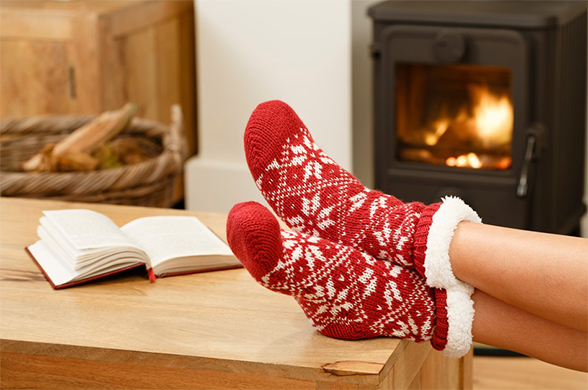It’s that time of year – the time when we’d love to grab a book and a beverage and cuddle up in front of a cozy fire. A fireplace or wood stove can take the chill out of the air and a few dollars off your heating bill. But what you burn – and how you burn it – matters, not only for your fireplace or stove, but also for your health and safety. We’ve put together a few burning tips to help you safely enjoy your every glowing minute of your wood fire.
To Burn or Not to Burn – Here Are the Answers
Burn only seasoned wood – Freshly chopped firewood has up to 50% water content and won't burn properly in your fireplace or wood stove. Firewood must be allowed to season, which means leaving it outside after it’s cut to allow the moisture to escape. Burning unseasoned (green) or even partially seasoned wood in your stove or fireplace will cause creosote build-up in your chimney, which could lead to fire failure, a roomful of smoke, or even a chimney fire.
Wood should be seasoned for at least 6 months. Store it outdoors while it seasons – off the ground, with the top covered. It will be ready to burn when it has a moisture content less than 20%. You can purchase inexpensive wood moisture meters at hardware stores and online.
Buy local – Invasive insects, like the Emerald Ash Borer, have decimated several species of native trees. One of the reasons they have caused so much destruction in just a few years is that they’ve been transported from place to place as they hid inside firewood. Buy and burn only locally cut firewood to decrease the risk of transporting invasive forest pests to your property. Learn more from the Don’t Move Firewood campaign.
Start smart – Only use newspaper, dry kindling, and all-natural or organic fire starters. Never start a fire in a fireplace or woodstove with gasoline, kerosene, or charcoal starter.
Know the ingredients – If you use manufactured logs, choose those made from 100% compressed sawdust. Many wax and sawdust logs are made for open hearth fireplaces only – check your wood stove or fireplace insert operating instructions before using artificial logs.
Keep it hot, hot, hot! – Once it’s started, keep your fire burning hot until you’re ready to put it out. A smoldering fire is never a safe or efficient fire.
Be air aware – Air quality, both indoors and out, is an important consideration when you’re using your fireplace or wood stove. Keep the doors of your wood-burning appliance closed unless loading or stoking the fire. Otherwise, harmful chemicals like carbon monoxide can be released into your home. Also, do your part to reduce outdoor air pollution by checking the local air quality forecast before you burn. If it’s a poor air-quality day, forego the burn, if you can.
Ban these from the burn – You may think you’re doing the environment a favor by burning flammable household products instead of adding them to a landfill. That’s probably not the case. Many of these materials can release toxic or harmful chemicals when burned, and may damage your fireplace or wood stove:
- Household trash, including cardboard, plastics, foam and the colored ink on magazines, boxes, and wrappers
- Coated, painted, or pressure-treated wood
- Plywood, particle board, or any wood with glue on or in it
- Wet, rotted, diseased, or moldy wood
- Plastic, asbestos, rubber, manure, and animal remains
In a nutshell: Unless it’s well-seasoned wood, dry kindling, newspaper, or organic fire starters, don’t burn it in your fireplace or wood stove.
More Best Burning Practices
In addition to monitoring what’s burning in your fireplace or wood stove, safety dictates that you should also monitor what’s around it.
Have your chimney and flue inspected and cleaned annually. Professional chimney cleaners will not only remove flammable (and smelly) creosote deposits, they’ll check your fireplace or wood stove and chimney for early signs of damage, so minor repairs won’t turn into major, costly ones.
Keep flammable items, like curtains, furniture, newspapers, and books, away from your appliance. It only takes one spark to ignite a devastating blaze.
Regularly remove ashes into a covered, metal container. Store the container outdoors on a nonflammable surface.
Install smoke detectors in every room of your house and at least one carbon monoxide detector on every level. Then test them once a month. Each year, more nearly 3,000 people in the U.S. die in residential fires and more than 150 die from carbon monoxide poisoning related to home-heating appliances.
Keep a fire extinguisher near your fireplace or wood stove. Every second counts when putting out a fire.
Learn more about residential wood heaters, such as fireplaces and wood stoves, from tips and guidelines offered by the U.S. Environmental Protection Agency’s Burn Wise program.
Contact Doctor Flue
Ready to schedule your annual cleaning and inspection? Contact us today! We’ll get you set up right away so that you can enjoy the benefits of your fireplace or wood stove with peace of mind.
Call Us: 1-800-438-3583
Email Us: office@drflue.com
Office Hours: Mon-Fri: 8am-4pm

